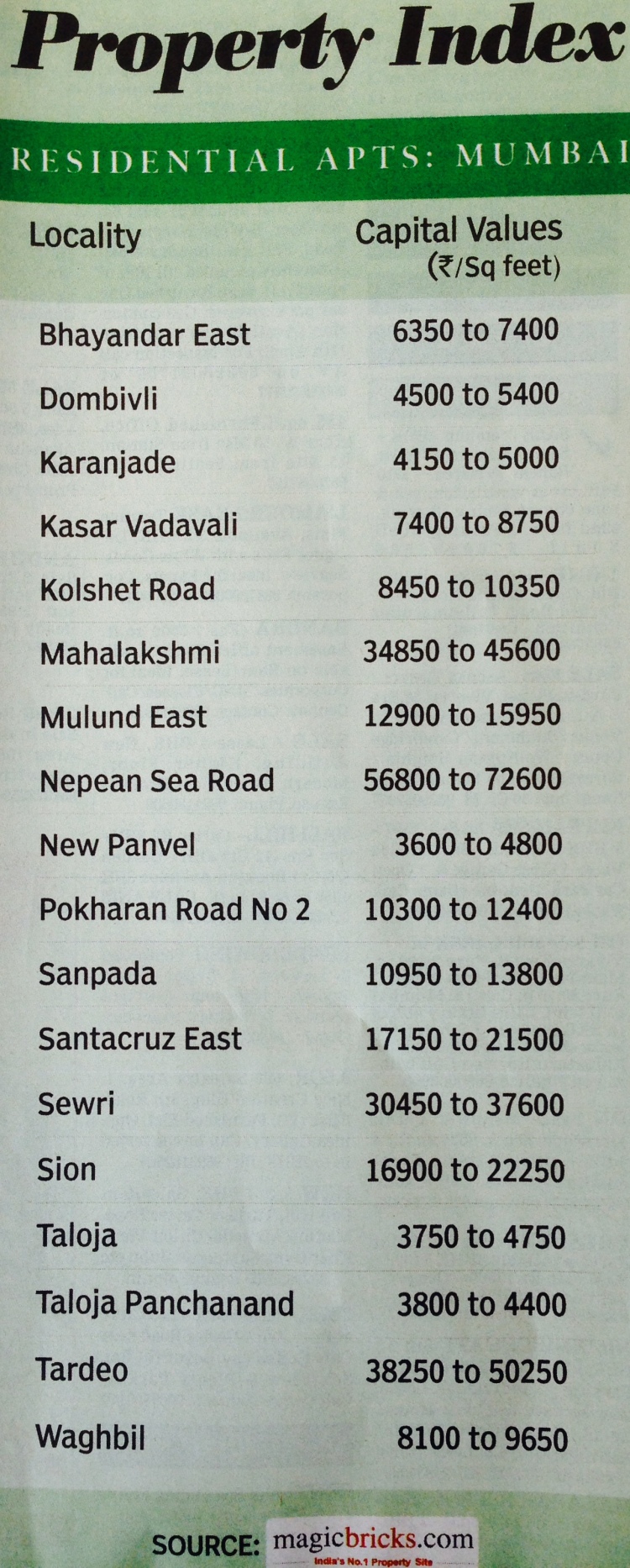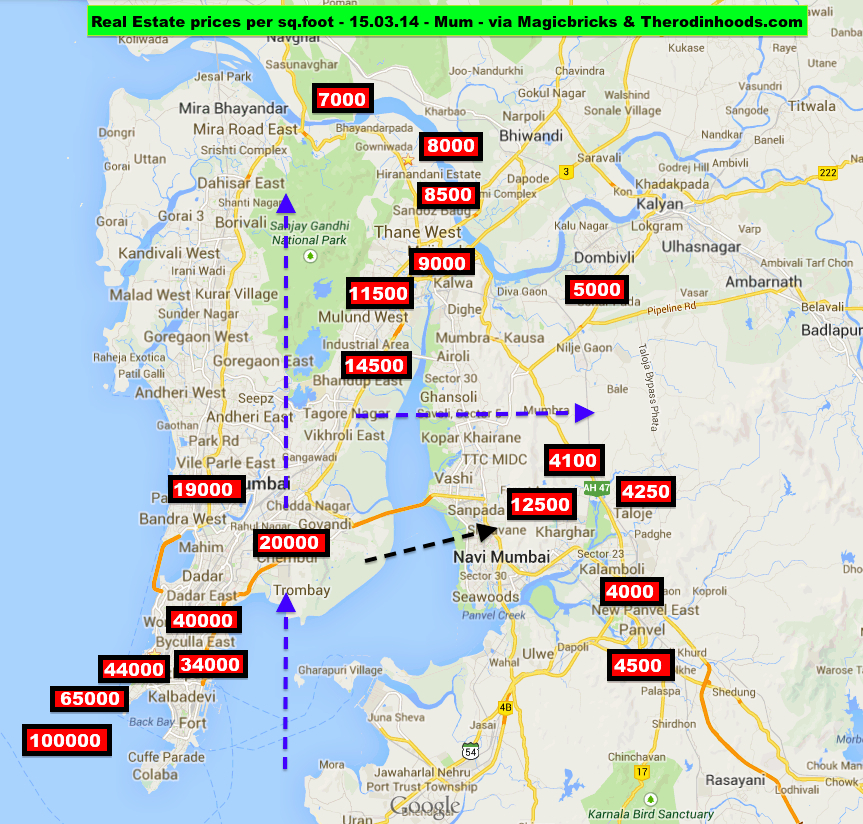I am sure all of you have noticed the oft-published ‘real-estate’ price charts that the daily papers publish.
I have been staring at them for a long time now and have been trying to explain a thesis to my wife Chhavi to justify a real estate decision I made a few months back 🙂
Today, I decided to ‘Mapify’ that thesis (since real estate sits on a map) and decided to share it with everyone!
Check out (Click to expand and feel free to download):
All I have done is juxtaposed the real estate prices of the report on to google maps to represent the data visually:
Now my THESIS:
Look at the bottom left of the map:
Apartments in Cuffe Parade (the southernmost tip of residential Mumbai) are routinely selling for Rs. 88,000-100,000 per square feet. The same rate applies to apartments in a building like Samudra Bhavan at Worli and many iconic buildings in Malabar Hills etc.
My theory is that the price of real estate in Mumbai gravitates from the south and radiates upwards and sideways in an pulsating fashion (slowing down as it goes farther). See the faint dotted blue arrows.
As South Mumbai continues to climb, so also other areas go up, in a ratio directly proportionate to their distance from South Mumbai.
Check the Black Arrow! It also points to a ‘hidden’ logic that the places nearest to SOBO even across the small strait of Ocean (Sanpada in this case) should be higher priced than other places!
Now, prices in South Mumbai ARE CHEAP! The ‘iconic’ addresses in Manhattan, New York and in the West End in London sell for 10 lac per sq. feet; so South Mumbai has space to creep vertically upwards, as it has done for the past 3 decades.
Using my thesis, I have placed a bet on an area directly in the direction of the pulse and I hope that pays out 🙂
The same could be used by you (at your own risk :))
Tell me what you think of my thesis, and if you disagree then don’t tell Chhavi :
Data source:

*****






Gurpreet Singh Tikku
The Rates and theory looks Justified.
The only hitch I see is that most of Ultra HNI Investors are shifting their Investments from Residential properties to Commercial Properties.
The main cause for the same is the Rental income/Regular income.
The RoI with regards to RENTAL in Commercial properties is around 6 to 10% pa compared to return on residential properties which is less than 3%.
Also, new companies getting registered every day in India (MNC’s and Indian) signals towards good office requirement in India in next few years.
Karan Pandhi
Alok,
Your view is not wrong, but Manhattan and West End both these places have different currencies the Dollar and pound, so if West End sells at 10 lacs per sq. ft. in pounds it will be 10,000 pounds.
Now if the salary check is done, it will be much easier for a guy living in London to earn 10,000 pounds per month to buy a place in West End in a few long years.
Where as for a guy to earn ten lacs per month is a big Pain in the butt in India. Thus it is expected for those prices in Europe and U.S. to be higher than India.
Alok Rodinhood Kejriwal
hahahaha my bhai… the PPP is NOT 10
Look up the Big Mac Index to get real PPP’s
Ankit Sawant
Sir Ji,
Dombivli rates are around 10-12k for new construction and old ones around 7k-9k!
Magic Bricks’ data seems wrong! 🙂
Rahul Jain
Totally agree with the thesis that prices will increase as you radiate out from South Mumbai but disagree that Mumbai can be benchmarked to New York or London. My thesis is we will see South Mumbai plateau or grow very slowly while strategic areas in the ‘burbs experience a far stronger growth rate in order to try and play catch up. I have long been an advocate for the global benchmarking thesis (pushed family to invest in South Mumbai since 90s when the gap between Mumbai and London, New York was larger) but I can no longer support it for the following reasons:
1) Mumbai is not a world class city like London or New York. Much of the high end iconic real estate there is purchased by foreign investors looking for safe harbor for their money from fickle governments. New York attracts Russians, Chinese, South American investors. London attracts Arabs and Russians. Geneva Arabs, Miami South Americans. Mumbai?
2) PPP – Big Mac index shows india has the lowest PPP amongst the benchmark countries. It makes sense then that real estate prices cannot match those of New York, London et all https://www.economist.com/content/big-mac-index
3) South Mumbai Real Estate is at rs. 70000- 1lac per sq ft i.e. $1300-$2,000. Average in Manhattan is actually $1500 per sq ft. Iconic New York real estate is not very far ahead at approx $2,500 – $3,000. (15 Central Park South..the best building in Manhattan home to CEOs is $5,000 per sq ft but that is the best of the best..). London, Singapore, Hong Kong, Zurich are well ahead..
4) Anecdotally, I can recall when the gap between South Mumbai and Manhattan was $150-200 / sq ft in the late 90s (dollar adjusted). Now there is no real gap.
5) Your thesis is spot on in Mumbai IMO. Mumbai city center is shifting as the city expands. I believe that the suburbs of mumbai where the new sealinks are touching removing them from relative isolation – Chembur etc and silicon valley zone around Powai provides compelling values and appreciation potential vs. South Mumbai. Holiday areas accessible from Mumabi are perhaps the biggest 5-10 baggers..Pawna etc. I’m no expert on this but initial research tells me this thesis is strong.
6) Within 25mins of Manhattan connected by train, bus and ferry I can get beautiful high end doorman buildings with gym, pool, views and parks for $300-$400/sq ft (New Jersey right across Manhattan, Connecticut, Westchester). The smartest marwari real estate investor I know is raising money in India and buying right around New York (he is also buying prime commercial space in Manhattan and warehouses and food chain infrastructure plays in Mumbai)
Just my take being a NRI based around NYC with strong ties to Bombay.
Gurpreet Singh Tikku
A Painter’s Painting appreciates at a higher pace, after the Painter is Dead.
Similarly in Real Estate, the property will appreciate more if no new supplies come in.
In South Mumbai, Low rises are being cleared to make place for High rises… And till the time this supply is maintained, a very high appreciation is not possible.
Secondly, I always believe that Developing area with good Infrastructure would appreciate more then a Developed Area.
Samruddha Salvi
Which are are you betting on?